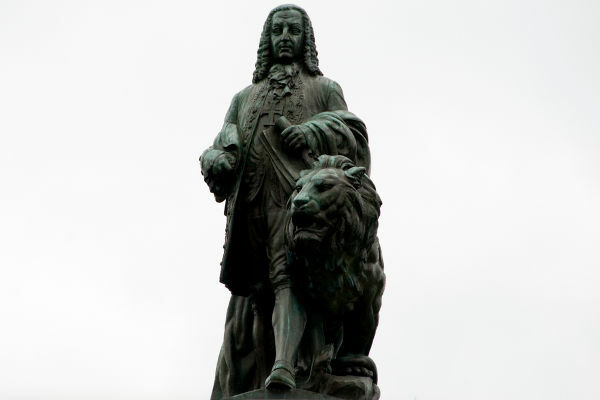THE InconfidenceMinas Gerais, or ConjurationMinas Gerais, that's how the character revolt became known separatist which was being organized in the captaincy of Minas Gerais at the end of the 18th century. This revolt was organized by the socioeconomic elite of Minas Gerais and ended up being discovered by the Portuguese Crown before it started. Tiradentes was one of those involved in this revolt.
Also access: Understand how mining worked in colonial Brazil
Background
THE captaincy of Minas Gerais was the richest in Brazil, due to the extraction of gold and diamonds in the region. The exploration brought enormous wealth and made Minas Gerais prosper and grow. The Portuguese Crown's attention to its most important captaincy was redoubled and, in the 18th century, the relationship between the inhabitants of the captaincy and the Crown began to show signs of wear.
In 1720, for example, the Revoltinvillagerich, motivated by the dissatisfaction of the local population with the high taxes levied by the Crown. Other revolts took place, but they were not intended to separate the captaincy from the Portuguese Crown.

During the administration of the Marquês de Pombal, Portugal increased taxes levied in Brazil and strengthened Minas Gerais' dissatisfaction with the Crown.*
From the second half of the 18th century, the politicsSupervisor of Portugal in relation to the colony became more rigid. Portugal, governed by the Marquis of Pombal, ordered the increased tax collection in Brazil as a way to finance the reconstruction of Lisbon, destroyed by a earthquake in 1755. This contributed to erode the relationship between the colonists and the Crown to the point that, in the 1780s, a conspiracy.
Also access: Discover the reforms carried out in Portugal during the Pombaline administration
Do not stop now... There's more after the advertising ;)
Participants
THE Mining Conjuration was a conspiracy organized by socioeconomic elite of the captaincy of Minas Gerais. In the words of historians Lília Schwarcz and Heloísa Starling, the group that formed the conspirators of the conjuration they were people who “had family, friendship or economic ties” that linked them with the “society summit of Mines"|1|.
They also highlight that, despite being formed mostly by members of the socioeconomic elite, the group was composed of people from the most diverse professions, such as poets, canons, engineers, doctors, soldiers, merchants etc.|2| The humblest member of the conspiracy of economic status was Joaquim José da Silva Xavier, O Tiradentes, commander of the troop that monitored the road (Caminho Novo) that linked Rio de Janeiro to Minas Gerais. He, in turn, was one of the most participatory members of the spellcasting.
Read too:Arcadismo – the literary school that emerged in the context of the Inconfidência Mineira
Causes
As discussed briefly, the Inconfidência Mineira was the result of dissatisfaction of the economic elite of the captaincy of Minas Gerais with the fiscal policy imposed by the Portuguese Crown. This dissatisfaction existed throughout the 18th century, but from the 1780s it gained strength and an air of separatism, giving a new dimension to this political movement.
The precise moment when the Minas Gerais elite began to conspire against the Crown is not known, but it is known that it was at some point in the 1780s. Those involved in this revolt had in mind that the taxes charged by Portugal were excessive, but they were also imbued with other ideals – such as separation from Minas Gerais and its transformation into a republic.
Lília Schwarcz and Heloísa Starling draw attention to a fact: the conjuration was the result of resentment, but also from the perception that Minas Gerais was able to exist without the presence of a controlling crown. They were aware that the captaincy had the economic conditions to support itself.|3|
The trigger for the outbreak of the movement against the Crown happened during the administrations of LuísgivesWedgeMeneses It's from ViscountinBarbacena, both governors of the captaincy. The first had a corrupt administration that harmed the interests of the local elite in favor of their personal friends.
In the administration of Visconde de Barbacena, an order was sent to comply with the annual gold quota, which was stipulated by the Crown. To meet this quota, the "spills”, the mandatory collection with the objective of reaching the hundred arrobas of gold. This caused outrage because the local economy was in crisis due to the drop in the amount of gold extracted.
The possibility of a spill alarmed the local elite and anticipated preparations for an uprising against the Crown. The conspirators planned to start the revolt on the day the spill was carried out. One of the great propagandists of this conspiracy was Tiradentes.
Read too: Brazil wood – the first raw material explored in our country
What did the inconfidentes stand for?
The claims made by the inconfidentes were varied, but, in general, they can be summarized in the following points:
proclamation of a republic along the lines of the United States;
holding of annual elections;
encouraging the installation of manufactures as a way to diversify the economic production of Minas Gerais;
formation of a national militia composed of the citizens of Minas Gerais.
In the matter of slavery, there was no consensus among the inconfidentes. Thus, some defended the liberation of slaves, but others defended the permanence of slavery if the captaincy achieved its independence.
The settlers thought of carrying out a revolt in Vila Rica that would later spread throughout the captaincy. To succeed in this endeavor, the inconfidentes planned a attrition war that would force the Portuguese Crown to negotiate an end to hostilities. They sought international help from Americans and French and even had a few nods of support, but that did not materialize into effective action.
How did the Inconfidência Mineira end?

Tiradentes was the only one involved in the Inconfidência Mineira to be sentenced to death.
The secret meetings that organized and disseminated the principles of this revolt against Portugal went on for years, but the movement didn't even get to the point of being triggered. This is because, even before its outbreak, denunciations made the Crown aware that a conspiracy was taking place.
On May 18, 1789, some of the inconfidentes were informed that the conspiracy against Portugal had been discovered. The Viscount of Barbacena received six complaints about an ongoing conspiracy in Minas Gerais. The most important complaint was made by Joaquim Silverio dos Reis.
Silverio dos Reis was involved in the conspiracy and owed large sums of money to the Portuguese Crown. He ended up denouncing the movement organized by the Inconfidentes as a way to have their debts forgiven. Silvério dos Reis' report gave all the details of the strategy of the inconfidencia and allowed colonial authorities to plan the repression against those involved.
The Viscount of Barbacena ordered the suspension of the spill and started the prisons and interrogations. The entire process of prosecuting prisoners for involvement in the conspiracy stretched over three years and was a demonstration of the Crown's power as a way of discouraging other such conspiracies.
The reading of the sentence, as stated by historian Boris Fausto, lasted eighteen hours|4|. At convictions were the most diverse and included sentences such as exile (expulsion to Africa), life imprisonment, sentence to hang etc. Several of those involved were sentenced to death on the gallows, but d. Maria, Queen of Portugal, pardoned all but one of the condemned: Tiradentes.
Tiradentes was arrested in Rio de Janeiro in May 1789. His death was used as an example of intimidation and occurred because Tiradentes was the movement's great propagandist. When arrested, he was on a trip to publicize the conspiracy being organized.
Tiradentes turned out to be hanged in day April 21, 1792, in Rio de Janeiro. Was butchered and parts of his body were scattered along the road that connected Rio de Janeiro to Minas Gerais. His head was put on display in the central square of Vila Rica and would remain there until it rotted away, but it ended up disappearing and its whereabouts are still unknown to this day.
The Conjuração Mineira was one of the most important revolts organized against the Portuguese Crown and showed the colonists' willingness to break the colonial bond and the existence of idealsrepublicans within the main Brazilian captaincy. A few years later, it was Bahia's turn to rebel against Portuguese rule in Bahia Conjuration.
Also access:Understand what Enlightened Despotism was in force in Portugal in the 18th century
Inconfidence or Conjuration?
The movement we study in this text is known as Inconfidência Mineira or Conjuração Mineira. Both ways can be used to refer to this historical event, although there is a debate among historians as to which term is more appropriate to use.
Many historians do not use "inconfidence" under the allegation that it was a term coined by the Portuguese Crown and its use is in line with a perspectivecolonizer. The word “inconfident” is used to refer to a traitor, a disloyal, unfaithful person. From the Portuguese perspective, all those who turned against Portugal were traitors, therefore, inconfidentes.
Thus, there are historians who consider “conjuration” a more appropriate way of referring to this event.
|1| SCHWARCZ, Lilia Moritz and STARLING, Heloísa Murgel. Brazil: A Biography. São Paulo: Companhia das Letras, 2015, p. 142.
|2| Idem, p. 142.
|3| Idem, p. 143.
|4| FAUSTO, Boris. History of Brazil. São Paulo: Edusp, 2013, p. 101.
*Image credits: appreciate and Shutterstock
By Daniel Neves
Graduated in History

